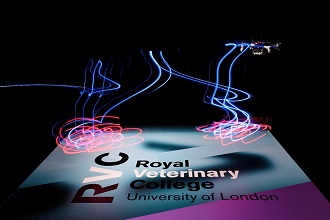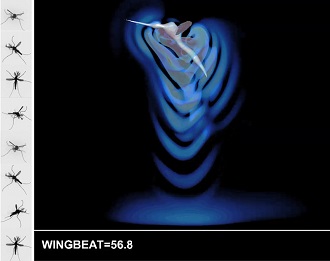
How Mosquitos Avoid Obstacles in the Dark
A collaborative research group led by the RVC has demonstrated how the mosquito avoids obstacles in the dark by sensing changes in the airflows generated by its flapping wings.

Challenge
Nocturnal mosquitoes navigate in the dark without crashing into surfaces. When they land on humans or other animals to feed, they do it very gently in order to remain stealthy – being noticed could spell disaster. Since these nocturnal mosquitoes cannot see what they are doing with their eyes, they use a different sensory mode – mechanosensing.
Mosquitoes, and other flying animals, fly by accelerating the air around them, creating fast jets beneath each flapping wing. These jets change shape in the presence of obstacles such as the ground or walls. Thanks to an exquisitely sensitive array of receptors at the base of the antennae on mosquitoes' heads, called the Johnston’s organ, the mosquito is capable of detecting these changes in airflow patterns. The researchers called this "aerodynamic imaging" as it gives the mosquito a picture of the world around them even in the dark and when they cannot feel surfaces by physical contact.
The research team developed a mosquito-inspired quadcopter equipped with an elegant collision-avoidance sensory system – which encodes aerodynamic information on the fly.

Solution
The team used computational fluid dynamics simulations, based on high-speed recordings of mosquito flight, to investigate the effects of the ground and walls on airflows around the body. They discovered a trend: the Johnston’s organs on the antennae detect airflow changes very easily at low altitude, with the response diminishing at higher altitudes, until the threshold for detection is not met.
They were surprised to see that one of the locations with the largest differences in airflow patterns occurs above the head, which means that the insects’ antennae were optimally positioned to sense these changes despite being farthest away from the ground.
Aeroplane and helicopter pilots will be familiar with a phenomenon called ‘ground effect’ which tends to come into play when very close to the ground, usually noticeable at an altitude lower than two wing lengths. Using their new data, the researchers predicted the maximum distance at which the Culex mosquito can detect surfaces: more than 20 wing lengths, which is far larger than the expected distance for detection based on existing aerodynamic models.
The team’s next step was to transfer the concept of aerodynamic imaging to a miniature quadcopter. They fitted the vehicle with a bio-inspired sensor device made from an array of probe tubes connected to differential pressure sensors. By measuring the airflow velocities around the quadcopter, the researchers identified where to place the probes for maximum sensitivity. The device was flown near the ground and walls first tethered, then piloted, and, finally, autonomously.
This simple model was able to detect surfaces and raise the alarm successfully at distances sufficient to avoid obstacles when approaching the ground and walls. Unlike previous surface-sensing quadcopter studies, this model requires only basic thresholds with little to no processing to function. It is lightweight, power-efficient, and scalable.
Impact
The team validated the principle that encoding aerodynamic information can enable collision avoidance by developing a quadcopter with a sensory system inspired by the mosquito. Such low-power sensing systems have major potential for future use in safer rotorcraft control systems.
Richard Bomphrey, Professor of Comparative Biomechanics at the RVC, said: "It's important to understand how such a significant group of insects navigate around the world. If we are to live in a future where ever more work is done by flying vehicles and drones, it could be useful to take some inspiration from mosquitoes to make our machines safer when operating close to buildings or other infrastructure.
"There is no reason to stop at small fliers, this surface detection capability could be scaled-up to helicopters, making them a little safer when flying in treacherous, low-visibility conditions."
Partners and funders
Biotechnology and Biological Sciences Research Council (BBSRC)
Defence Science and Technology Laboratory (DSTL)
Publications
| Title | Publication | Year |
| Aerodynamic imaging by mosquitoes inspires a surface detector for autonomous flying vehicles | Science | 2020 |
